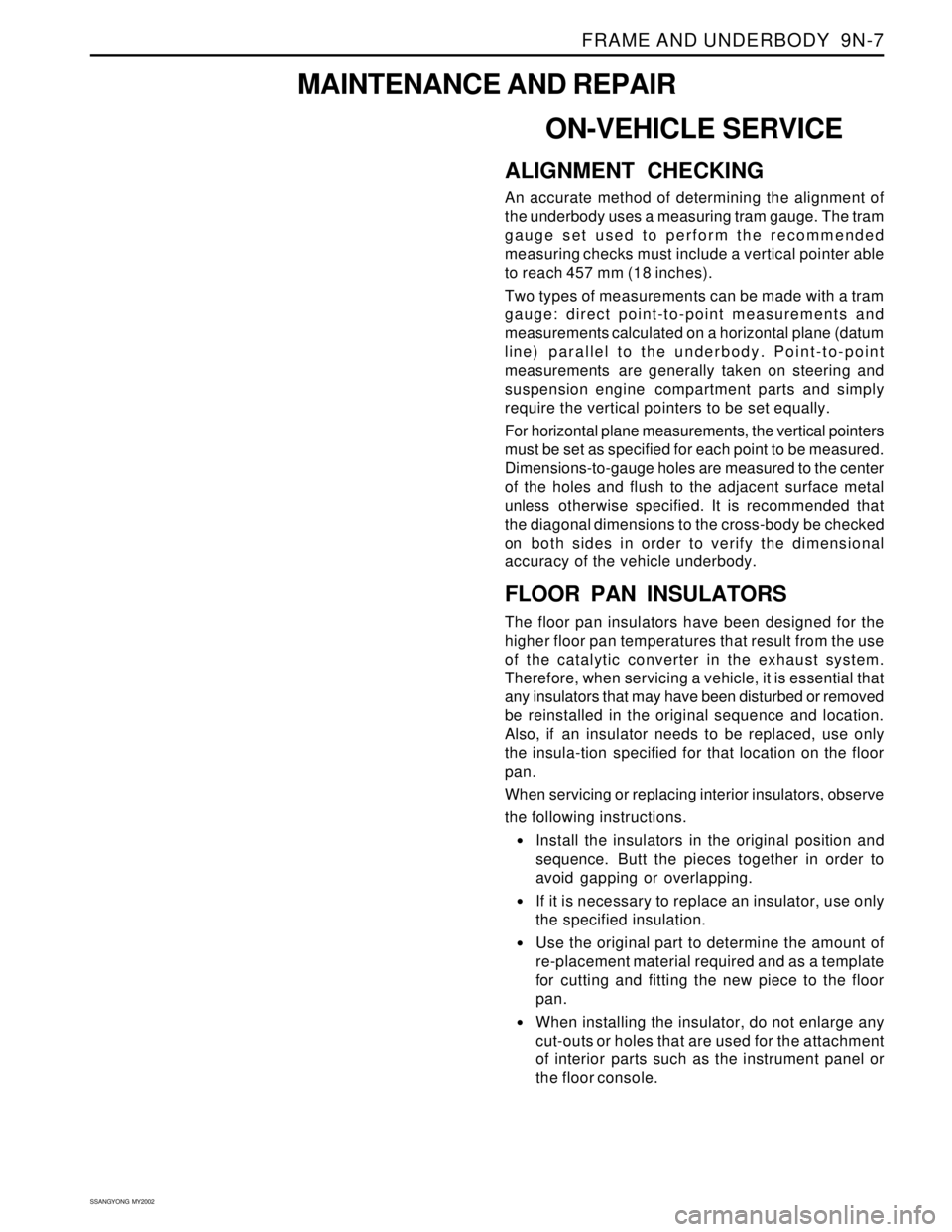Page 1776 of 2053
SECTION 9J
WINDNOISE
TABLE OF CONTENTS
Diagnosis..............................................................9J-2
Windnoise Diagnosis ...........................................9J-2Maintenance and Repair.....................................9J-3
On-Vehicle Service.................................................9J-3
Windnoise Repair................................................9J-3
Page 1778 of 2053
WINDNOISE 9J-3
SSANGYONG MY2002
MAINTENANCE AND REPAIR
ON-VEHICLE SERVICE
WINDNOISE REPAIR
Windnoise leak repairs are very similar to waterleak
repairs. Refer to Section 9I, Waterleaks. The actual
procedure depends on the type of seal being repaired.
Leaks around the door opening weatherstrips do not
al-ways indicate a faulty weatherstrip. A door or window
adjustment may resolve the condition. Refer to Section
9P, Doors or Section 9L, Glass and Mirrors.
Page 1779 of 2053
SECTION 9K
SQUEAKS AND RATTLES
TABLE OF CONTENTS
Diagnosis..............................................................9K-2
Squeak and Rattle Diagnosis...............................9K-2Maintenance and Repair.....................................9K-4
On-Vehicle Service.................................................9K-4
Squeak and Rattle Repair....................................9K-4
Page 1782 of 2053
SSANGYONG MY2002
9K-4 SQUEAKS AND RATTLES
MAINTENANCE AND REPAIR
ON-VEHICLE SERVICE
SQUEAK AND RATTLE REPAIR
Squeaks and rattles are caused by the unwanted move-
ment between parts of a vehicle. There are three means
to prevent squeaks or rattles.
Attach the parts securely so that there is no relative
motion during the operation of the vehicle.
Separate the parts so that there is no contact during
operation.
Insulate the parts so that no squeaks or rattles occur
with the movement of the parts. Low uniform friction
surfaces can be used to eliminate “stick-slip”
motion.
Page 1803 of 2053
SECTION 9N
FRAME AND UNDERBODY
TABLE OF CONTENTS
Specifications.......................................................9N-2
Fastener Tightening Specifications.......................9N-2
Underbody Dimensions.......................................9N-3
Maintenance and Repair.....................................9N-7
On-Vehicle Service.................................................9N-7
Alignment Checking............................................9N-7Floor Pan Insulators.............................................9N-7
Engine Under Covers ...........................................9N-8
General Description and System Operation........9N-9
General Body Construction..................................9N-9
Engine Under Covers ...........................................9N-9
Page 1809 of 2053

FRAME AND UNDERBODY 9N-7
SSANGYONG MY2002
ON-VEHICLE SERVICE
ALIGNMENT CHECKING
An accurate method of determining the alignment of
the underbody uses a measuring tram gauge. The tram
gauge set used to perform the recommended
measuring checks must include a vertical pointer able
to reach 457 mm (18 inches).
Two types of measurements can be made with a tram
gauge: direct point-to-point measurements and
measurements calculated on a horizontal plane (datum
line) parallel to the underbody. Point-to-point
measurements are generally taken on steering and
suspension engine compartment parts and simply
require the vertical pointers to be set equally.
For horizontal plane measurements, the vertical pointers
must be set as specified for each point to be measured.
Dimensions-to-gauge holes are measured to the center
of the holes and flush to the adjacent surface metal
unless otherwise specified. It is recommended that
the diagonal dimensions to the cross-body be checked
on both sides in order to verify the dimensional
accuracy of the vehicle underbody.
FLOOR PAN INSULATORS
The floor pan insulators have been designed for the
higher floor pan temperatures that result from the use
of the catalytic converter in the exhaust system.
Therefore, when servicing a vehicle, it is essential that
any insulators that may have been disturbed or removed
be reinstalled in the original sequence and location.
Also, if an insulator needs to be replaced, use only
the insula-tion specified for that location on the floor
pan.
When servicing or replacing interior insulators, observe
the following instructions.
•Install the insulators in the original position and
sequence. Butt the pieces together in order to
avoid gapping or overlapping.
If it is necessary to replace an insulator, use only
the specified insulation.
Use the original part to determine the amount of
re-placement material required and as a template
for cutting and fitting the new piece to the floor
pan.
When installing the insulator, do not enlarge any
cut-outs or holes that are used for the attachment
of interior parts such as the instrument panel or
the floor console.
MAINTENANCE AND REPAIR